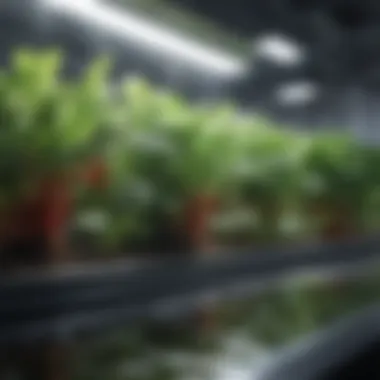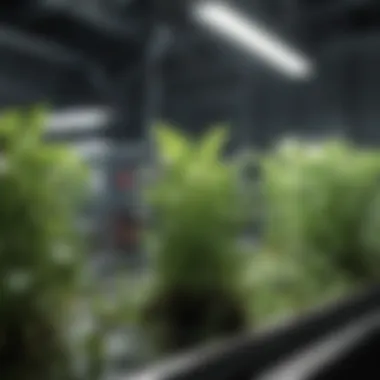Essential Insights into Hydro Garden Supply


Intro
Hydroponics represents an innovative method of growing plants without soil, relying on nutrient-rich water solutions instead. This technique is becoming increasingly popular among farmers and gardening enthusiasts alike. Its appeal lies not just in the ability to cultivate plants in limited space but also in optimizing resources to increase crop yields while minimizing environmental impact.
Understanding the components and functionality of hydro garden supply is crucial for anyone engaging in this form of horticulture. Equipment selection, nutrient management, and sustainable practices play a significant role in the success of hydroponic systems. This article aims to provide a systematic exploration of these elements, ensuring that both novices and experienced horticulturists can effectively harness the benefits of hydroponics.
Research and Data Analysis
Latest Trends in Agriculture and Horticulture
The agricultural landscape is evolving, influenced by advancements in technology and changing consumer preferences. Hydroponic systems are at the forefront of this revolution, driven by their efficiency and sustainability. More growers are adapting to controlled environment agriculture, leading to better-quality crops and resource conservation.
In recent years, vertical farming has gained traction, allowing for multiple layers of crops in a compact area. This method not only saves space but also results in higher productivity. Integrating automation and IoT (Internet of Things) devices is also becoming common in hydroponics, helping growers maintain optimal conditions with less manual intervention.
Statistical Insights into Crop Yields
Research indicates that hydroponic systems can produce yield increases of up to 30% compared to traditional soil-based agriculture. Key statistics show that the average growth cycle for certain leafy greens can decrease significantly, allowing for quicker turnover.
- Lettuce growth: Typically, five to six weeks in soil; only three to four weeks in hydroponics.
- Tomatoes: Improved yield per plant can reach 25% higher in hydroponic setups.
"Hydroponics is not just a growing trend; it is a viable solution for food production challenges worldwide."
Best Practices and Techniques
Efficient Crop Management Strategies
Implementing effective crop management strategies is essential for maximizing production in hydroponics. Key practices include:
- Monitoring Environmental Conditions: Regular check-ups on pH, nutrient concentration, and climatic conditions help maintain a healthy growing environment.
- Rotational Planting: Alternating crops can prevent nutrient depletion and pest issues, promoting a healthier ecosystem.
- Nutrient Management: Tailoring nutrient solutions to specific crop needs is vital for optimal growth and resistance.
Sustainable Horticultural Techniques
Sustainability within hydroponics is achievable through several approaches. Some notable techniques include:
- Water Recycling: Collecting and reusing water reduces waste, minimizing the overall resource footprint.
- Integrated Pest Management: Using natural predators and organic pesticides instead of chemical alternatives helps maintain ecosystem balance.
- Organic Nutrient Sources: Utilizing compost teas and other organic materials can enhance plant health without synthetic additives.
Pest and Disease Management
Common Pests and Diseases in Crops
Hydroponic systems, while beneficial, are not immune to pest and disease issues. Identifying common adversaries is crucial:
- Aphids: Known to sap nutrients from plants, leading to stunted growth.
- Powdery Mildew: A fungal problem that thrives in humid environments, affecting leaf health.
- Root Rot: Often caused by overwatering or poor sanitation, it can quickly destroy root structures.
Integrated Pest Management Strategies
Utilizing integrated pest management (IPM) can mitigate pest issues effectively. Essential components include:
- Regular Monitoring: Routine checks help detect problems early.
- Biological Controls: Introducing beneficial insects like ladybugs can keep pest populations in check.
- Cultural Practices: Clean growing environments and crop rotation can significantly reduce disease pressure.
Understanding these challenges and employing effective solutions are vital for anyone engaged in hydroponic gardening. This will ensure healthier crops and more sustainable practices overall.
Prolusion to Hydroponics
Hydroponics has emerged as a revolutionary practice in the gardening domain. It represents a method of growing plants without soil, instead utilizing nutrient-rich water solutions. This technique is increasingly important as it addresses various challenges faced by modern agriculture, including land degradation and water scarcity. Hydroponics also provides a space-efficient alternative, allowing for cultivation in urban settings where traditional gardening may be impractical.
Implementing hydroponics can lead to improved plant growth. The absence of soil minimizes the chance of pests and diseases that often plague traditional farming. In addition, it facilitates precise control over nutrients, which can significantly enhance yield and crop quality. Given these factors, understanding hydroponics is crucial for anyone looking to optimize their gardening efforts.
Understanding Hydroponic Systems
Hydroponic systems vary widely, each designed to cater to differing plant types and growth environments. Common systems include deep water culture, nutrient film technique, and aeroponics. Each method has its own operational principles and advantages. For instance, deep water culture involves suspending plant roots in a nutrient solution, ensuring constant access to water and nutrients.
In contrast, the nutrient film technique uses a thin film of nutrient solution flowing over plant roots, providing a constant supply of essential nutrients while allowing for adequate oxygenation. Selecting the right system depends on the specific requirements of the plants being cultivated, as well as available resources and space.
Benefits of Hydroponic Gardening


The benefits of hydroponic gardening are numerous. Some key advantages include:
- Higher Yields: Hydroponics often produces higher yields compared to traditional methods, as plants can access nutrients more efficiently.
- Water Conservation: Hydroponic systems utilize less water than soil-based gardening. The water is recirculated, which minimizes waste.
- Fewer Pests: As there is no soil, there are fewer pests and diseases, reducing the need for chemical pesticides.
- Faster Growth: Plants generally grow faster in hydroponic systems due to optimal nutrient and moisture availability.
"Hydroponics offers a sustainable solution to food production, making it a promising avenue for the future of agriculture."
Given these benefits, the integration of hydroponics into agricultural practices is becoming increasingly relevant. Gardeners and farmers can leverage this method to ensure robust plant growth, increase efficiency, and adapt to changing environmental conditions.
Core Components of Hydro Garden Supply
Understanding the core components of hydro garden supply is essential for any horticulturist looking to optimize their gardening practices. These components play a vital role not only in plant growth but also in the overall efficiency of hydroponic systems. Familiarizing oneself with these elements enhances the capacity to make informed choices, ultimately leading to better yields and healthier plants.
Grow Mediums
Types of grow mediums
Various types of grow mediums exist to support plant roots in hydroponic systems. Common options include coconut coir, rock wool, perlite, and vermiculite. Each of them offers unique characteristics that can benefit specific types of plants.
- Coconut Coir: This organic medium retains water well while providing decent aeration, making it suitable for many hydroponic setups.
- Rock Wool: Known for its excellent water retention and aeration, rock wool is popular among commercial growers but can require careful handling due to its pH level.
- Perlite and Vermiculite: Both are lightweight, sterile, and often mixed with other mediums to improve drainage and aeration.
Selection criteria for plant types
Choosing the right grow medium depends largely on the type of plant being cultivated. Factors to consider include the root structure, moisture requirements, and overall growth pattern of the plants. For instance, larger plants may require a medium that supports greater stability, while leafy greens might thrive in lighter mediums with better drainage.
For optimal plant health, matching the grow medium to the needs of the plant is crucial. A poor choice can result in stunted growth or even plant failure, complicating the overall effort in hydroponics.
Nutrient Solutions
Essential nutrients for plant health
Plants require certain essential nutrients to thrive. These nutrients are commonly categorized as macronutrients—nitrogen, phosphorus, potassium—and micronutrients such as iron and manganese. Understanding these nutrients and their functions is key to formulating effective nutrient solutions.
- Macronutrients promote primary growth and affect the overall vigor of the plants.
- Micronutrients, while needed in smaller amounts, play critical roles in photosynthesis and nutrient uptake.
Selecting the right balance of these nutrients is vital. An imbalanced solution can lead to deficiencies or toxicities that can affect plant growth negatively.
Formulating nutrient solutions
Creating a balanced nutrient solution involves knowing the specific needs of the plants. Factors, such as growth stage and environmental conditions, will influence formula adjustments.
- Regularly testing the nutrient solution’s pH and electrical conductivity is crucial for maintaining an optimal environment for nutrient uptake.
- Adjustments may include adding chelated micronutrients, changing concentrations, or even switching to organic solutions based on specific growing goals.
Lighting Equipment
Types of grow lights
Light is a critical component in any hydroponic setup. Various types of grow lights, such as LED, fluorescent, and high-intensity discharge (HID), are commonly used. Each type has unique energy requirements and light output.
- LED Grow Lights: More energy-efficient and have a longer lifespan compared to other light options, making them a popular choice for many home gardeners.
- Fluorescent Lights: They are affordable and ideal for growing seedlings or smaller plants but may not offer enough intensity for larger crops.
- HID Lights: Typically used by commercial growers, they provide high light intensity, suitable for larger plants needing more light.
Light spectrum and plant growth
The light spectrum greatly influences plant growth and development. Different wavelengths promote specific growth responses.
- Red light (around 660 nm) is crucial for flowering and fruiting, while blue light (around 450 nm) is essential for vegetative growth.
- Understanding how to effectively use different spectrums can significantly enhance growth efficiency in hydroponic gardens.
Pumps and Watering Systems
Types of pumps used in hydroponics
A reliable pumping system is essential for maintaining water levels and nutrient flow in hydroponic gardens. Various pumps exist, including submersible pumps and inline pumps.
- Submersible Pumps: These are placed directly in the nutrient solution and are often quieter and more efficient.
- Inline Pumps: These are installed outside the solution and are excellent for larger systems requiring high pressure and flow rates.
Automated watering solutions


Automating watering in hydroponics can improve consistency and reduce labor. Systems can include timers and sensors that monitor moisture levels.
- Timers allow for precise control over watering schedules, ensuring plants receive adequate moisture based on their needs.
- Sensors help in determining when to water, preventing over or under-watering that can cause stress to plants.
By understanding the core components of hydro garden supply, one can significantly enhance the effectiveness of hydroponics. Knowledge of grow mediums, nutrient solutions, lighting, and watering systems leads to more informed decisions, aligning closely with cultivation goals and improving overall gardening practices.
Navigating Hydro Garden Supply Options
Navigating through the various options for hydro garden supply is crucial for anyone involved in hydroponics. A clear understanding of the choices available can lead to better outcomes, whether one is a novice gardener or an experienced horticulturist. This section elaborates on some specific elements to consider, including system selection and sourcing supplies. Each choice carries weight in terms of plant health, growth rates, and production efficiency.
Choosing the Right Hydroponic System
Choosing the correct hydroponic system is fundamental to successful gardening. There are several types of hydroponic methods available, and knowing which one suits your needs is critical.
Comparing hydroponic methods
When comparing hydroponic methods like nutrient film technique (NFT), deep water culture (DWC), and aeroponics, it's essential to recognize their distinct characteristics. Each method operates with different mechanics and is suited to various types of plants. For example, NFT is efficient for lettuce, while DWC can handle larger plants like tomatoes.
The unique feature of NFT is its need for a constant flow of nutrients, making it a less water-intensive option. Its main advantages include faster growth rates and lower overall water usage. However, it requires careful monitoring to prevent root disease.
On the other hand, DWC allows for easier management but requires more space. This balance between efficiency and management enhances flexibility in choosing a method, which makes comparing them vital for anyone.
Cost considerations
Cost is another critical aspect of the decision-making process. Each hydroponic system comes with its own investment requirements, from equipment to ongoing maintenance costs.
A common characteristic of systems like vertical farming setups is higher initial costs but may yield better returns over time due to space efficiency. If budget considerations are paramount, simpler systems like wick systems can be cheaper initially. However, they might not yield crops as effectively as more involved setups.
Investing in a more robust system usually results in better plant performance and faster growth cycles. This, in turn, can justify the upfront expense.
Sources for Hydro Garden Supplies
Understanding where to source hydro garden supplies is an underappreciated yet critical factor in the gardening process. The choice between online retailers and local suppliers can significantly impact the ease of obtaining necessary materials.
Online retailers vs. local suppliers
Online retailers often provide a broader selection of supplies, which might not be available in local stores, like specialized nutrient blends or advanced lighting. This variety promotes better-informed decisions, with customers having the ability to compare products and prices easily.
However, relying solely on online options can lead to delays in receiving materials, a significant disadvantage when immediate needs arise. Local suppliers may offer faster delivery through direct purchase and are also useful for quicker advice and support based on regional conditions.
Assessing supplier reliability
Assessing supplier reliability adds yet another layer of complexity in the sourcing process. A good supplier will not only sell quality products but also support customers with valuable insights. Their reputation can often be gauged through online reviews and feedback from other gardeners.
The key characteristic is the ability to provide consistent quality and support. A reliable supplier can make the difference between a successful crop cycle and a failed one. While it may seem tempting to choose the cheapest option, suppliers who prioritize quality often result in better long-term relationships and outcomes in the garden.
"The efficiency of your hydroponic system relies significantly on making informed choices regarding supplies and methods."
Taking time to evaluate these aspects will empower gardeners to make significant strides in enhancing their practice, ultimately yielding more bountiful harvests.
Sustainable Practices in Hydroponic Gardening
Sustainable practices in hydroponic gardening are critical for securing the environment and ensuring efficient resource usage. As the world faces challenges like climate change and growing population, the importance of adopting sustainable methods cannot be underestimated. Hydroponic gardening already minimizes land use and can significantly reduce water consumption. By integrating sustainable practices, gardeners can further enhance the positive impact of their efforts while optimizing plant growth. In this section, we will explore two key areas of sustainable practices: water conservation techniques and organic nutrient solutions.
Water Conservation Techniques
Recirculating systems
Recirculating systems play an essential role in hydroponic gardening. They allow for the reuse of water by recycling nutrient solutions. This approach not only reduces water consumption but also helps maintain optimal nutrient levels for plants. A key characteristic of recirculating systems is their efficiency. These systems can use 90% less water compared to traditional gardening.
One unique feature of recirculating systems is their ability to minimize waste. Since the water is continually cycled through the system, the risk of water surplus or leaching is substantially reduced. However, one disadvantage can be the initial setup cost and complexity. Proper management is necessary to avoid issues like nutrient deficiencies.
Monitoring water usage
Monitoring water usage is another crucial technique in sustainable hydroponic gardening. It involves tracking the amount of water being utilized throughout the gardening process. This ensures that water is not wasted and allows for adjustments to be made as needed. The key characteristic of monitoring is precision. By keeping accurate records, gardeners can optimize their systems for greater efficiency.


The unique feature of monitoring water usage is that it can help identify patterns in water consumption over time. This data can indicate potential leaks or inefficiencies in the system. However, monitoring may require additional tools or software, which can be seen as a disadvantage for some gardeners.
Organic Nutrient Solutions
Using natural amendments
Using natural amendments in hydroponics provides a sustainable alternative to synthetic fertilizers. Natural amendments refer to organic substances that enrich the growth medium with essential nutrients. This practice is beneficial as it contributes to healthier plants and less environmental impact. One of the key characteristics of using natural amendments is their safety. Many organic nutrients are less likely to cause chemical build-up in the soil or water.
A notable feature of using natural amendments is their potential to improve soil structure and density. They can enhance microbial activity which benefits plant growth. However, the drawback is that the nutrient release may not be as immediate as synthetic options, so careful planning is needed.
Implementing composting in hydroponics
Implementing composting in hydroponics is a method that can yield numerous benefits. Composting provides a way to create nutrient-rich organic matter from food scraps and other biodegradable materials. This practice contributes to sustainability by reducing waste. One key characteristic of composting is its ability to improve soil fertility naturally.
The unique feature here is the quality of nutrients derived from compost. These nutrients are often more balanced and safer for plants than many commercial fertilizers. However, a disadvantage of composting in hydroponics is the time it takes to create compost, which may not be suitable for all gardeners, especially those wanting immediate results.
Sustainability in hydroponic systems not only reduces environmental impact but also contributes to healthier crops and better yield overall.
Future Trends in Hydroponics
The future of hydroponics holds vast potential, shaping the landscape of modern agriculture. This section dives into technological innovations and market trends that are transforming this industry. Understanding these future trends is crucial for anyone invested in horticulture. The rise of urban farming, advancements in automation, and evolving nutrient management systems are all pivotal in enhancing food production and sustainability.
Technological Innovations
Automation in hydroponic systems
Automation is a key aspect of contemporary hydroponic systems. The integration of technology not only streamlines processes but also minimizes human error. Automated systems often include sensors for monitoring environmental conditions, which can optimize growth conditions. One of the hallmark characteristics of automation is its efficiency.
By automating tasks like nutrient delivery and pH balancing, farmers can ensure consistent conditions for their crops. This leads to higher yield and better quality produce. However, some disadvantages include the initial high investment and a steep learning curve. As such, this can be a barrier for new growers without technical expertise.
Advancements in nutrient management
Nutrient management has become increasingly sophisticated. Modern tools often incorporate real-time data analytics to tailor nutrient delivery precisely to plant needs. This dynamic approach allows for continuous adjustment based on plant growth stage and environmental conditions. A major benefit of advancements in nutrient management is the significant reduction in waste, commonly seen in traditional farming systems.
Incorporating technology here ensures plants receive the right nutrients at the right time, resulting in improved plant health. However, the challenge can lie in the complexity of managing these systems. Users must remain vigilant to prevent over-fertilization and other nutrient-related issues.
Market Growth and Demand
Rising interest in urban gardening
Urban gardening is witnessing a surge in popularity, driven by a growing awareness of food sustainability and the demand for fresh produce in urban areas. This trend contributes significantly to the hydroponics market, as more city dwellers seek ways to grow their food. The key characteristic of this movement is its accessibility. Hydroponics can be implemented in limited spaces, making it ideal for small apartments or rooftops.
The unique feature of urban gardening is that it fosters a community around food production. This can enhance social interactions and encourage local economies. Eco-conscious consumers increasingly support small growers, creating a vibrant marketplace for hydroponic produce.
Global trends in hydroponics
Globally, hydroponics is gaining traction as a viable solution for food security challenges. Countries facing land scarcity or extreme climates are investing in hydroponic technologies. The characteristics of this trend include adaptability and niche markets. These systems can be customized to fit various environmental conditions, enabling farming in places once deemed unsuitable for traditional agriculture.
A critical advantage is the potential for constant, year-round crop production. This is particularly vital in regions with harsh winters or drought conditions. However, the reliance on technology can be a disadvantage in areas with limited access to resources or infrastructure.
The future of hydroponics not only promises efficient food production but also addresses critical issues such as sustainability and urbanization.
As these trends evolve, it becomes imperative for stakeholders in the agriculture sector to engage with this changing landscape. Understanding and adopting these innovations will pave the way for sustainable practices in hydroponic gardening.
Culmination
Summarizing Hydro Garden Supply Resources
The key resources involved in hydro garden supply encompass several core components. Understanding these resources can optimize your gardening efforts.
- Grow Mediums: Knowing the types of grow mediums and considering the right selection based on plant types are crucial in providing adequate support for root growth.
- Nutrient Solutions: Recognizing essential nutrients and how to formulate effective nutrient solutions directly shapes plant health and productivity.
- Lighting Equipment: Familiarity with different types of grow lights and understanding how light spectrum affects growth can enhance plant development significantly.
- Pumps and Watering Systems: Different types of pumps, as well as automated watering solutions, can streamline your gardening process.
It is valuable to assess both online retailers and local suppliers for hydro garden supplies to ensure you receive quality products that meet your garden's needs.
Encouraging Best Practices
Adopting best practices in hydroponics promotes sustainability and efficiency. Implementing water conservation techniques, such as using recirculating systems, is essential for minimizing waste. Additionally, organic nutrient solutions, created from natural amendments and effective composting processes, can boost plant health and yield.
For enhanced results, consider regular monitoring of both water and nutrient levels. This practice will help preemptively identify issues that could hinder plant growth.
In summary, a solid understanding of hydro garden supply resources and the integration of best practices will not only empower agricultural enthusiasts but also contribute to a more sustainable form of gardening.















